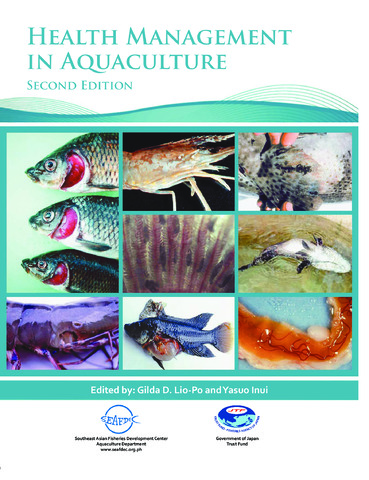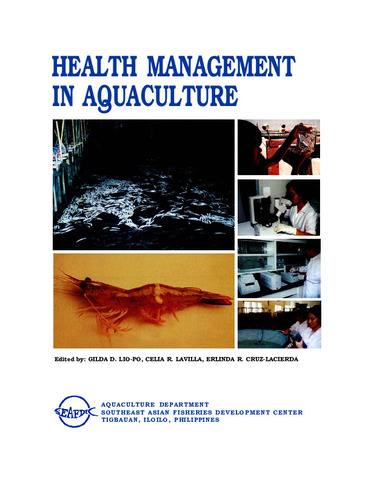Occurrence of lymphocystis disease in cultured tiger grouper Epinephelus fuscoguttatus in Malaysia
| dc.contributor.author | Oseko, Norihisa | |
| dc.contributor.author | Palanisamy, V. | |
| dc.contributor.author | Kua, Beng Chu | |
| dc.contributor.author | Thye, Chuah Toh | |
| dc.contributor.editor | Lavilla-Pitogo, Celia R. | |
| dc.contributor.editor | Cruz-Lacierda, Erlinda R. | |
| dc.date.accessioned | 2021-10-22T05:58:06Z | |
| dc.date.available | 2021-10-22T05:58:06Z | |
| dc.date.issued | 2002 | |
| dc.identifier.citation | Oseko, N., Palanisamy, V., Kua, B. C., & Thye, C. T. (2002). Occurrence of lymphocystis disease in cultured tiger grouper Epinephelus fuscoguttatus in Malaysia. In C. R. Lavilla-Pitogo & E. R. Cruz-Lacierda (Eds.), Diseases in Asian aquaculture IV: Proceedings of the Fourth Symposium on Diseases in Asian Aquaculture, 22-26 November 1999, Cebu City, Philippines (pp. 213-217). Fish Health Section, Asian Fisheries Society. | en |
| dc.identifier.isbn | 9718020160 | |
| dc.identifier.uri | http://hdl.handle.net/10862/6211 | |
| dc.description.abstract | Lymphocystis-like disease was observed in the pond cultured juveniles of tiger grouper (Epinephelus fuscoguttatus) at a farm in Penang Island, Malaysia in May 1999. Clinical signs were abnormally dark colored patches with numerous nodules on the skin. The histopathological study showed that the nodules were composed of many enormously hypertrophied cells commonly 300 - 400 µm in size. Each cell was surrounded by a hyaline capsule and epithelioid structure. The cytoplasm consisted of an enlarged nucleus with prominently stained nucleoli. These histological characteristics of the hypertrophied cells were similar to the lymphocystis cells that were reported in other fish species like bluegill (Lepomis marcochirus) and European flounder (Platichthys flesus). Under electron microscopy, many virus particles were observed in the hypertrophied cell s cytoplasm. These particles showed typical hexagonal profiles with a size of 220-257 nm. The nodules disappeared from the affected parts of the body after fish were maintained for 75 days in an aquarium with clean water. The clinical signs, histopathological findings, and electron microscopical observations showed that the fish were suffering from lymphocystis disease. Lymphocystis is well known to have a wide range of hosts among freshwater and marine fishes. This is the first reported occurrence of the disease in tiger grouper in Malaysia. | en |
| dc.publisher | Fish Health Section, Asian Fisheries Society | en |
| dc.subject | Malaysia | en |
| dc.title | Occurrence of lymphocystis disease in cultured tiger grouper Epinephelus fuscoguttatus in Malaysia | en |
| dc.type | Conference paper | en |
| dc.citation.spage | 213 | en |
| dc.citation.epage | 217 | en |
| dc.citation.conferenceTitle | Diseases in Asian aquaculture IV: Proceedings of the Fourth Symposium on Diseases in Asian Aquaculture, 22-26 November 1999, Cebu City, Philippines | en |
| dc.subject.asfa | grouper culture | en |
| dc.subject.asfa | diseases | en |
| dc.subject.asfa | fish diseases | en |
| dc.subject.asfa | electron microscopy | en |
| dc.subject.asfa | histopathology | en |
| dc.subject.scientificName | Epinephelus fuscoguttatus | en |
このアイテムのファイル
| ファイル | サイズ | フォーマット | 閲覧 |
|---|---|---|---|
|
このアイテムに関連するファイルは存在しません。 |
|||
このアイテムは次のコレクションに所属しています
-
Diseases in Asian aquaculture IV [43]
Proceedings of the Fourth Symposium on Diseases in Asian Aquaculture, 22-26 November 1999, Cebu City, Philippines



